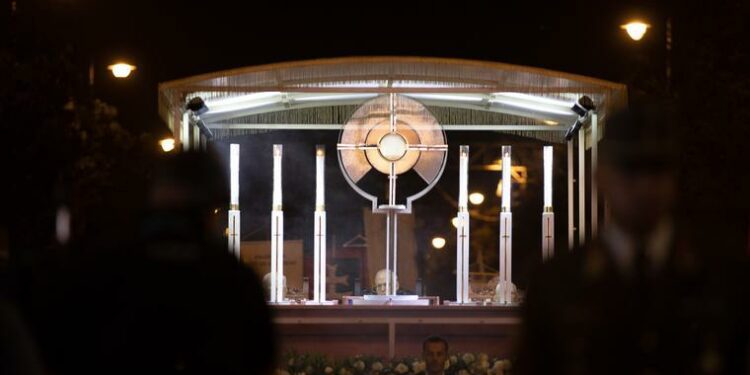The U.S. has hosted two international Eucharistic congresses: 1926 in Chicago and 1976 in Philadelphia. These are not to be confused with the 10 national Eucharistic congresses that have been hosted in the U.S. over the years, including the recent one in Indianapolis. The early congresses were confined to European countries until 1893, when the first congress outside of Europe took place in Jerusalem — a fitting location as the site of the very first Mass in the Upper Room. The congress was attended by hundreds of Latin Rite and Eastern Rite patriarchs, bishops, priests and faithful.Â
Other notable congresses include: the 19th in 1908, held in London, which marked the first one in the English-speaking world; the 21st, in 1910, held in Montreal, the first one in North America and the Western Hemisphere; the 32nd, in 1932, held in Dublin to coincide with the 1,500th anniversary of St. Patrick’s arrival to Ireland; and the 38th, held in 1964 in Bombay, which was the first time a congress was held in a non-Christian country with the goal of sharing the doctrine of the Real Presence with nonbelievers. This congress was attended by Pope Paul VI, who was joined by many cardinals and 20,000 foreign visitors. The last international congress was held in Budapest, Hungary, in 2021.
Such large-scale public witnesses of faith in the Eucharist have borne much fruit, the most notable of which is continued growth in devotion to the Real Presence. Eucharistic congresses essentially serve one main purpose: to reinforce to the faithful that Our Lord is indeed fully present in the Eucharist.Â
 SPECIAL BLESSING. Schoolchildren in front of St. James Cathedral receive the blessing of the papal legate, Cardinal Vincenzo Vannutelli, Sept. 9, 1910, at the 21st International Eucharistic Congress in Montreal. Library of Congress
SPECIAL BLESSING. Schoolchildren in front of St. James Cathedral receive the blessing of the papal legate, Cardinal Vincenzo Vannutelli, Sept. 9, 1910, at the 21st International Eucharistic Congress in Montreal. Library of Congress
As many saints, popes and others have noted throughout the Church’s history, it is from this truth that the life of the Church finds its unfettered root. During the 45th International Eucharistic Congress in Seville, Spain, in 1993, Pope St. John Paul II expressed hope that the congress would result in “the establishment of perpetual Eucharistic adoration in all parishes and Christian communities throughout the world.”Â
Over the last 30 years, it seems as though this hope has come to fruition, with many perpetual adoration chapels continuing to crop up globally.Â
The Pope’s words from the closing Mass of that congress sum up well the Church’s Eucharistic vision. “From the Eucharistic altar, the pulsating heart of the Church, the evangelizing flow of word and charity is constantly born,” he said. “For this reason, contact with the Eucharist must lead to a greater commitment to make present the redemptive work of Christ in all human realities.”
Source link : http://www.bing.com/news/apiclick.aspx?ref=FexRss&aid=&tid=66d96a4f053f499aa25b0542aea65bcf&url=https%3A%2F%2Fwww.ncregister.com%2Fnews%2Finternational-eucharistic-congress-eucador&c=8733620481889997621&mkt=en-us
Author :
Publish date : 2024-09-04 04:52:00
Copyright for syndicated content belongs to the linked Source.











